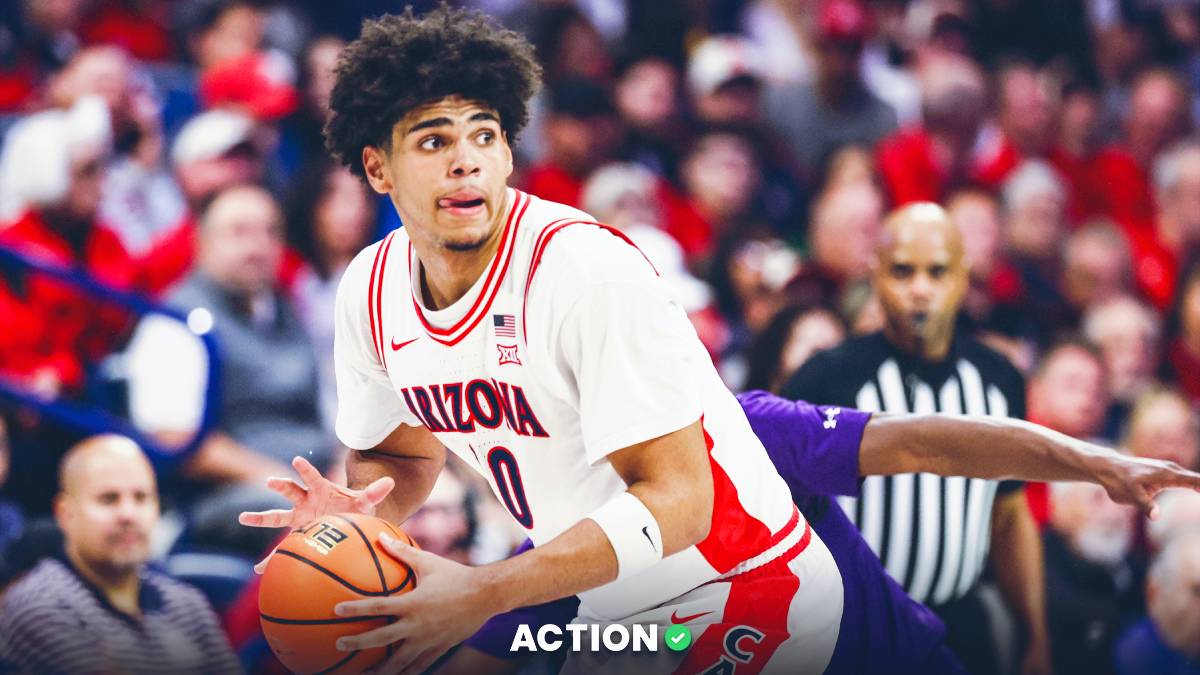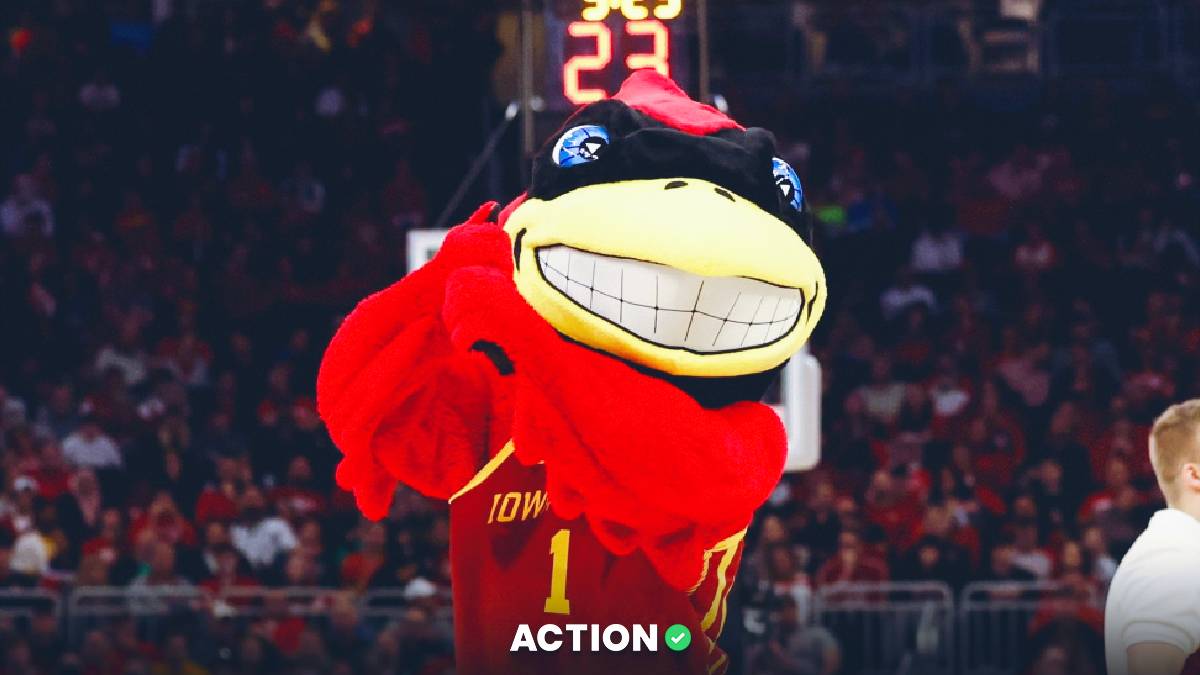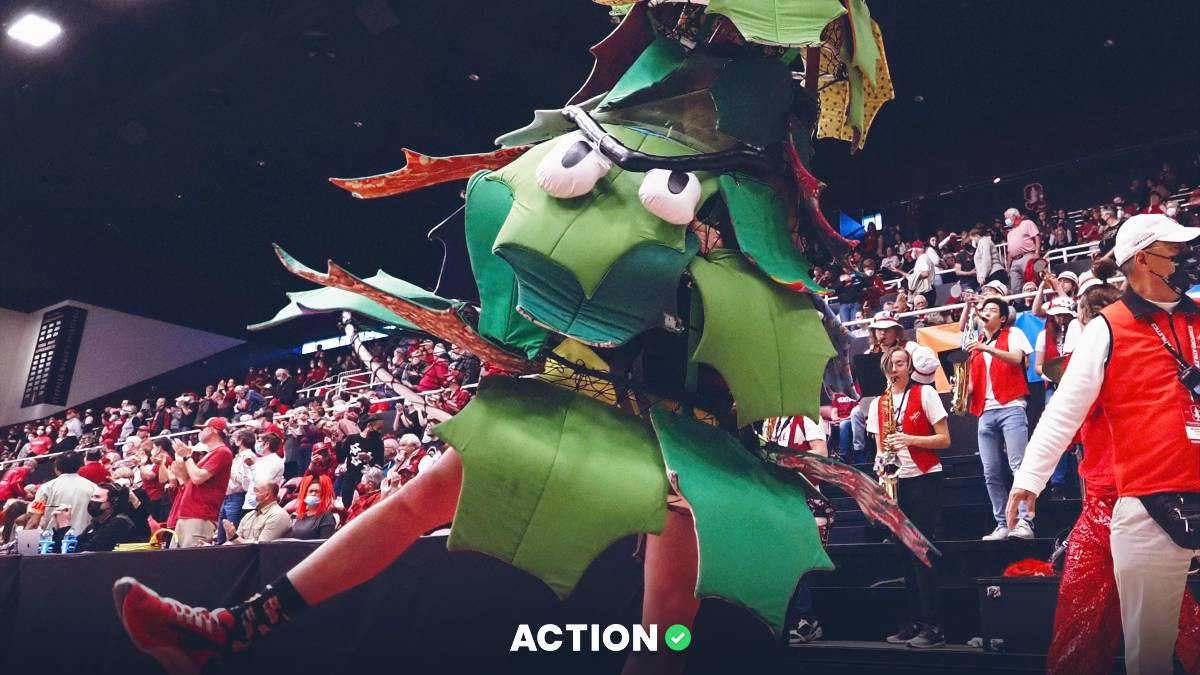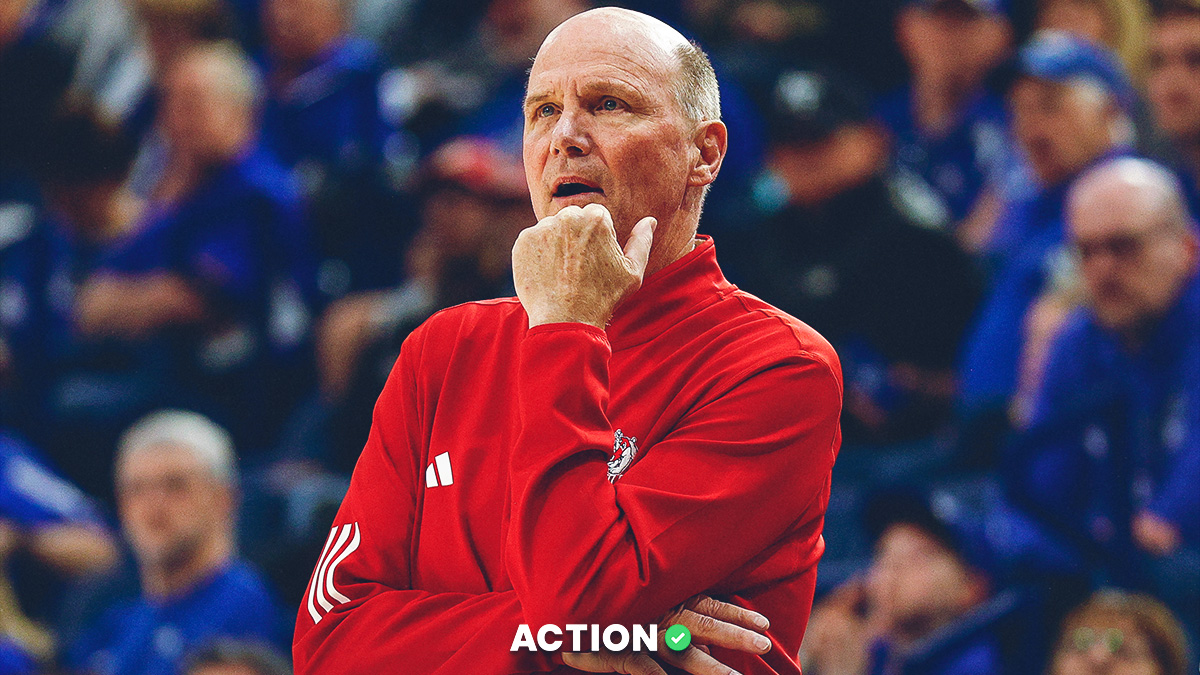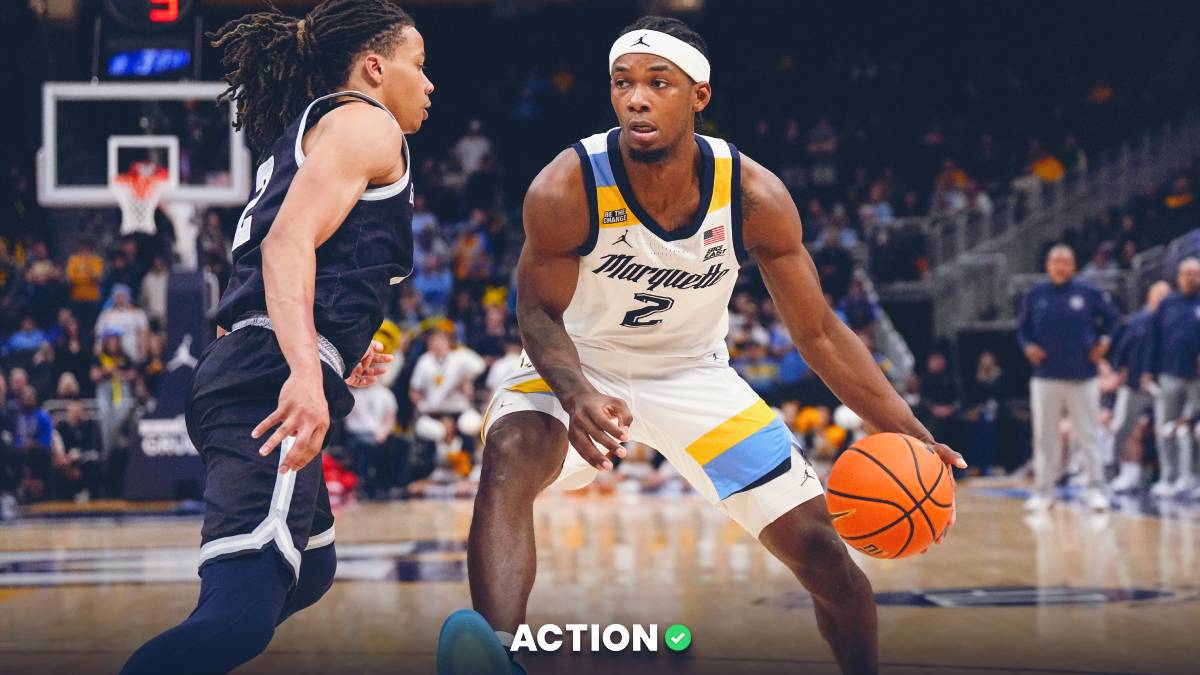1. Grand Canyon
It's time to unleash the Thunder! The Lopes' four-year transition period is finally over, meaning GCU is eligible for the NCAA Tournament, and the timing is perfect, as Dan Majerle has them positioned to be the class of an unusually deep WAC.
STRENGTHS: Backcourt/wings. Defense. Depth. Versatility. Home-court advantage.
Starting with the backcourt, Casey Benson comes in from Oregon and will immediately take over the point guard role for the departing DeWayne Russell. Russell was the focal point of the GCU offense last year, and while Benson isn't as good of a defender, he's more of a traditional pass-first lead guard, and he has plenty of options to score around him, starting with Joshua Braun, who should lead the Lopes in scoring this year. Braun is currently dealing with concussion issues, but he posted a .482/.401/.803 shooting slash en route to a 119.2 ORtg. Per HoopLens, GCU fired at 1.05 points per possession with Braun on the floor and just 0.98 when he was off. With a less iso-driven point in place with Benson, Braun is due for a monster year. Shaq Carr and highly-touted frosh Damari Milstead are also options on and off the ball in the backcourt. The wing corps around Braun is certainly the strength of the team, as 6-foot-7 Oscar Frayer returns as GCU's best athlete, solid rebounder and versatile defender. Combine Frayer with 6-foot-7 Gerard Martin, and GCU's ability to defend with length inside and out is unparalleled in this league. Martin can guard 1-5, and when Frayer and Martin were on the court together for 900 possessions last year, GCU held opponents to 0.91 points per possession. GCU has a chance to be elite defensively this year. Majerle finally recruited the size that has held his Lopes back against annually monstrous New Mexico State. A pair of 6-foot-10 Euro stretch 5s come to Phoenix in Roberts Blumbergs and Alessandro Lever. They'll join veterans Keonta Vernon and Matt Jackson. Vernon is one of the best rebounders in the WAC, while Jackson was a key stretch 4 two years ago before injury. If you're discussing GCU, you have to mention the Havocs at GCU Arena. The Lopes play in front of one of the most rabid fanbases not just in mid-majordom, but in all of D1 hoops. GCU Arena is basically Cameron Indoor West, and it's a truly remarkable home-court advantage the Lopes enjoy.
WEAKNESSES: Honestly, not too many.
The new Euro kids might get pushed around a little early, especially by NMSU, and there's some concern about Benson's defense.
SCHEME: Majerle runs a lot of ball screens to get Braun open in creative ways, and with the new stretch bigs and the return of Jackson, the spacing should much improved, and there's going to be less iso stuff with Russell gone. Defensively, GCU is very aggressive in man-to-man, and they can switch everything with their versatility on the wings. Despite the aggressive nature of the defense, GCU had the lowest defensive foul rate in the league. Like I said, this team can be elite defensively.
OUTLOOK: This is the year for Lopes, as postseason eligibility coincides with Majerle's best team. GCU could be as high as a 14 seed, and teams like Boise State, St. John's and Illinois should beware.
2. New Mexico State
STRENGTHS: Depth. Length. Coaching. Rebounding.
While I just raved about GCU, it would be unwise to dismiss NMSU, especially after they scored with a discounted Chris Jans to take over on the sidelines. Jans comes from the Gregg Marshall tree and inherits a talented, versatile roster that can immediately adapt to his aggressive man-to-man scheme that's actually incredibly similar to GCU's defense. Jans will work with an entirely new backcourt that features Ohio State transfer A.J. Harris on the ball and well-traveled scorer Zach Lofton off it. Harris is a born penetrator, while Lofton and a now healthy Sidy N'Dir provide scoring punch at the 2 and 3. The frontcourt of Eli Chuha and Jemerrio Jones is a strength for Jans as well. They're an undersized 4/5 combo, but both are athletic and versatile, and both can board — each posted top-30 offensive rebounding rates nationally. Chuha and Jones weren't on the floor much together last year, but NMSU scored at 1.16 points per possession in the 400-plus possessions that they were, per HoopLens. For bigger lineups, Jans has 6-foot-10 Johnathon Wilkins at his disposal as the team's best rim protector. Redshirt freshman Johnny McCants (a Las Cruces native) should fit in with Jans' overarching philosophy of defensive tenacity and relentless glass crashing.
WEAKNESSES: Perimeter shooting.
Harris, Lofton, N'Dir, Chuha and Jones are all incredibly reliant on getting the ball to the rim. NMSU is going to shoot free throws at one of the highest rates nationally, but proven perimeter shooting options are few and far between. 6-foot-3 frosh Gabe Hadley can fill that role somewhat, but NMSU's best perimeter offense is likely grabbing the missed shot for a potential putback.
SCHEME: Jans brings the Gregg Marshall "in your jersey" man-to-man defense, and his versatile 2/3/4 players can switch on everything. Offensively, he'll run a lot of motion offense meant to attack lanes off the dribble.
OUTLOOK: Jans immediately changed Bowling Green into a MAC contender, and that was with far less talent at his disposal (although Richaun Holmes was a monster) than he has in Las Cruces. He'll continue to have the Aggies battling as a premier team in this league.
3. Utah Valley
STRENGTHS: Defense. Depth. Transition attack.
The Wolverines are a team you're going to want to stream this year. Mark Pope has built a roster perfect for his NBA influenced "pace and space" style, and they're an underrated defensive squad that got even better with the addition of Oklahoma transfer Akolda Manyang. Senior Brandon Randolph (Xavier transfer) can be an electrifying catalyst in UVU's spread transition attack (the Wolverines have finished seventh and 13th nationally in tempo in Pope's two seasons), but he also had an absurdly high turnover rate on the ball last year. A second season in this system will help, and he's surrounded by a plethora of shooters. Conner and Jake Toolson and Ken Ogbe (currently recovering from a broken collarbone) are all volume perimeter shooters in Pope's spread pick-and-roll offense. Pope bolstered an already solid frontcourt with Manyang sliding next to Isaac Neilson, who can settle into more of a stretch 4 role this year. If Manyang can stay healthy (a big if given his injury history), he could post the nation's highest block rate. He's also athletic enough to run the floor in transition, meaning Pope won't have to slow down the offensive attack. In short, Manyang was a major addition on both ends of the court and could post a double-double nightly if he stays out of foul trouble. Ben Nakwaasah was underrated JUCO addition by Pope, and he can ease the ball handling load on Randolph. Pope lost Hayden Schenck, a quintessential glue guy, for the season, so Cory Calvert (another BYU transfer) will have a larger role than anticipated.
WEAKNESSES: Turnovers. Wing defense.
Simply put, Randolph turned the ball over way too much, and it undermined what could have been the league's most potent offensive attack. The loss of Schenck hurts what's an underwhelming wing defense that too often allows easy dribble penetration.
SCHEME: Pope runs an NBA-influenced spread-transition offense based on spacing within pick-and-roll. Defensively, Pope likes to aggressively take away the 3-point line, and with Neilson, the league's top shot blocker a year ago, joined by Manyang, UVU's defense should be among the best in the league — capable of shutting down the perimeter and funneling penetration into a fortress at the rim.
OUTLOOK: The fact that I have UVU third is a testament to the depth of the WAC this year. This is a team capable of winning the WAC tournament, and short of that, making a deep run in the CIT or CBI.
4. CSU Bakersfield
STRENGTHS: Defense.
Rod Barnes has turned CSUB into one of the best defensive systems in the entire country. The defense led to a WAC title two years ago and a run all the way to MSG in the NIT last year, and it should keep the Runners in the WAC title hunt this year despite some heavy losses in the backcourt. Brent Wrapp heads what returns of the backcourt, but he's the heart and soul of CSUB at the point. Wrapp posted the league's second-highest assist rate, he rebounds extremely well for a guard, and he posted top-10 league rates in steals AND blocks. Wrapp is currently nursing a foot injury, and if it lingers into the season, it could spell doom for the Runners in a deep year for the WAC. Wrapp's main offensive beneficiary is Damiyne Durham. Durham's a solid wing defender and rebounder, but his 85.8 ORtg in WAC play was a killer, compounded by the fact that he had the third-highest usage rate and highest shot rate in the league. In fact, Durham had the third-highest shot rate in the entire country. That said, the attention he draws from opposing defenses helps his teammates, and CSUB was significantly better (1.04 points per possession) with him on the court than off (0.97) in nearly equal amounts of possessions. Shonn Briggs should be in line for a massive senior season on the wing. Briggs was dominant offensively in the NIT run as a slashing wing. Moataz Aly anchors the frontcourt and is the brick wall on the back end of Barnes' pressure-heavy defense. Aly posted an absurd 18.9 percent block rate, but he didn't log enough minutes to qualify in KenPom's national standings. If so, he certainly would have topped the list. Few teams extended full-court pressure as much as CSUB last year, and with a shot blocker like Aly on the back end, the Runners' defense, which was the 20th-most efficient in the country last year, could be even better. CSUB held WAC opponents to just 0.89 points per possession and turned offenses over at a 23.4 percent clip, posting the league's highest steal and block rates. In short, the defense was elite on a national level, and it was even better when Aly could stay on the floor — CSUB's defense held opponents to 0.87 ppp in the 714 possessions he was on the court (although the offense fired at just 0.94 compared to 1.03 with him off). Fallou Ndoye works behind Aly at the 5, while James Suber should see an increased workload, especially if he continues to rebound his teammates' misses like he did in a small sample size last year.
WEAKNESSES: Offensive efficiency.
As I mentioned above, Durham and Briggs are likely the only reliable sources of offense, and Durham is inefficient and Briggs doesn't have a jump shot. Barnes will be relying on a slew of newcomers in the backcourt to help out in that regard, with Jarkel Joiner likely starting immediately as a third guard. Joiner averaged nearly 40 points a game as a Mississippi prep, while combo guard Rickey Holden and wing Justin McCall will see major minutes immediately as well. McCall is a defensive stopper and athletic wing who fits in perfectly in Barnes' scheme, while Holden might hold down the fort at the point if Wrapp's foot injury keeps him out to start the year.
SCHEME: Extremely high man-to-man ball pressure defensively has been Barnes' calling card at CSUB, but what's unique about the scheme is the fact that they don't allow anything at the rim on the back end when teams are able to handle it. In fact, only Cincy allowed a lower FG percentage at the rim than the Runners last year. Offensively, everything is predicated on attacking the rim and scoring on putbacks.
OUTLOOK: CSUB's oppressive defense will keep them in the title hunt, but a mediocre offense looks to be even less efficient this year.
5. Seattle
STRENGTHS: Coaching upgrade. Influx of transfer talent.
Jim Hayford makes his way from Cheney to Seattle in what was one of the bigger coaching coups of the offseason (and it should throw a little extra lighter fluid on that rivalry). Hayford also bolstered the roster with three impact grad transfers, one of whom he's very familiar with from his days in the Big Sky. In addition to the transfers that Hayford brought in, he also inherited a fairly talented roster, and he could have the Redhawks contending in the WAC in short order. At EWU, Hayford ran his offense through a point forward in Bogdan Bliznyuk the past two seasons, partly out of necessity and partly because it was actually working. He has a player capable of doing that on SU's roster in Matej Kavas, but he's probably best used as a floor spacer in Hayford's prolific 3-point offense. Kavas hit 40 percent from deep last year. Hayford has two options as a traditional point guard in Morgan Means and Wisconsin transfer Jordan Hill. He could play both together when he wants to run (Hayford's teams used to be among the fastest in the country) or play some traditional paint touch basketball centered around monstrous 7-foot-3 Aaron Menzies. Menzies has had foot issues, as is typical for players his size, but if he's healthy, Hayford knows how to make him efficient, just ask Jake Wiley, who parlayed his lone season under Hayford into an NBA career. Hayford can pair Menzies with a pick-and-pop 4 in Josh Hearlihy to open up the floor, while Richaud Gittens gives him athleticism and a lockdown defender on the wing. Hayford is well familiar with Gittens from his days at Weber State.
WEAKNESSES: Defense.
Even Hayford's best teams in Cheney were poor on the defensive end. Gittens is an upgrade on this end, as is Hill, but this is an area that SU will likely struggle in.
SCHEME: Everyone remembers the Tyler Harvey days at EWU when Hayford spread the floor in transition in one of the country's more prolific 3-point offenses. Last year with Wiley dominating touches in Cheney, Hayford slowed the offense to a crawl to accommodate. With Menzies lurking in the middle, I would expect to see the Hayford offense of last year, especially with a dearth of shooters on this year's roster. Defensively, I'm not sure what else to say about Hayford's "scheme", other than it's almost entirely man-to=-man.
OUTLOOK: Hayford bolstered this year's team with impact grad transfers, and he has an even better transfer class waiting for next year. He'll have SU contending in the WAC soon, if not this year.
6. UT Rio Grande Valley
STRENGTHS: Transition offense. Backcourt play.
You have to at least give Lew Hill credit for making UTRGV fun to watch through a 10-22 season that saw them score just two WAC wins (both over league doormat Chicago State). Hill brought his Lon Kruger-influenced transition offense to Edinburgh and cranked it to 11. Only seven teams in the country played faster than the former Broncos, and I would expect that pace to continue this year. That transition attack will be led by Nick Dixon, who will likely lead the WAC in scoring for a second consecutive season. Dixon posted a 116 ORtg in WAC play despite top-five usage and shot rates. He's a lethal penetrator (leading the league in contact rate and second in free throw rate) while spearheading Hill's high pressure defense. Lew Stallworth returns to give Hill a potent dual point guard look with Dixon, forming the crux of the team. Stallworth provides a shooting foil to Dixon's penetration (allowing Stallworth gets in the lane an awful lot himself). Xavier McDaniel showed flashes as an athletic freshman wing, as did Lesley Varner, with McDaniel being more of an offensive force and Varner a defensive factor in the press. Hill added two impact freshmen to the backcourt rotation in Greg Bowie and Javon Levi. Bowie in particular could pay immediate dividends as one of the best high school point guards in Texas last year. Former Texas Tech wing Jordan Jackson could start immediately for Hill as well, but the real coup in Hill's class is UTEP transfer Terry Winn (you could form a solid team with Tim Floyd's castoffs, and Hill might be trying, as Stallworth is one too). Winn won't be eligible until the second semester, but he'll immediately be the best option in the frontcourt.
WEAKNESSES: Defense.
Defense at the rim and in transition proved to be collateral damage in Hill's implementation of his pressure defense. Only three teams in the country allowed more shots at the rim, and only 17 allowed more shots in transition than the Vaqueros (two of those teams happen to be in the same eight-team league).
SCHEME: Heavy rim-attacking, transition-based offense spurred by a pressure defense that will alternate between matchup man-to-man press and a variety of zone traps.
OUTLOOK: Lots of high-scoring affairs and lots of losses, but with some appreciable gains overall.
7. UMKC
STRENGTHS: Depth.
It should be a long year for the 'Roos, but there's some reason for optimism. UMKC could have folded early last year following the dismissal of star guard Tez Harrison, but they battled through the year and finished by winning five of their last seven league games and even won a game in the CBI. Kareem Richardson will probably go at least 10 deep like last year, and maybe even 11 or 12 considering how young the Roos are and how many bodies his scheme requires. Sophomore Xavier Bishop and Isaiah Ross will be the fulcrum of the team. Bishop is a lightning quick but severely undersized point guard, while Ross can be a consistent spot shooter off the ball. (Richardson will surely be looking for more from him this year.) Broderick Robinson was Richardson's best all-around defender last year, and he showed promise as a jump shooter as well — a staple in UMKC's penetrate-and-kick heavy offense. A slew of freshmen bolster the backcourt after Richardson lost all five starters from last year. Brandon McKissic out of St. Louis is expected to contribute immediately. The frontcourt is sort of a disaster. Tony Jackson probably slots in at the 4 in Richardson's preferred smaller lineup, giving him some mismatch opportunities, while Aleer Leek has stretch 4 capabilities and Jordan Giles has the most upside offensively. Mo Ahmed is 7-foot-2 and will provide some much-needed rim protection when he can stay on the court.
WEAKNESSES: Defense. Experience.
Richardson will have one of the youngest teams in the country, and porous transition defense should be an issue again this year (no team in the country allowed FG attempts in transition at a higher rate than UMKC, per Hoop-math).
SCHEME: Richardson generally plays fast, relying on a deep backcourt to throw waves of Pitino-esque zone pressure at teams and ideally generate some transition opportunities. Unfortunately, the reverse happened last year, as the Roos were watching the backs of jerseys more than any team in the country.
OUTLOOK: It doesn't appear that UMKC will make it back-to-back years seeing postseason play, but it will be a good opportunity for Richardson to build depth and experience with an extremely young team.
8. Chicago State
STRENGTHS: Depth.
Poor Tracy Dildy. You have to feel for the guy. This is his eighth year at Chicago State, and that means years of traveling to Seattle, Edinburg, Bakersfield, etc. from Chicago. Being in the WAC is just absurd for the Cougars, but they didn't exactly have a lot of conferences knocking on their door either. Dildy always has a massive rotation, as he uses bodies to apply a frantic zone press that is meant to create chaos, but it more often than not results in easy buckets at the rim. Dildy has a decent scoring option in Fred Sims, who was second in the WAC scoring last year. Sims entered the draft (yes, the NBA draft), but ultimately returned to the South Side of Chicago. Sims will take about every CSU shot, as he led the WAC in usage and was second in shot rate. He's a good rebounder for his size and draws a lot of contact, but he posted a miserable 82.9 ORtg in league play, which is magnified by his domination of the ball. Wings Jelani Pruitt and Travon Bell sat out last year for Dildy, and both could make a difference this year, particularly Pruitt. Glen Burns returns at the point after missing the second half of last year with eligibility issues, while Deionte Simmons finished the year strong as one of Dildy's few frontcourt options. JUCO Anthony Harris probably starts with Pruitt and Sims on the wing, while Pat Szpir is Dildy's best rebounder and rim protector behind Simmons.
WEAKNESSES: Offense.
Chicago State scored at just 0.86 points per possession in league play, easily the lowest mark of any team in conference-only efficiency nationwide.
SCHEME: Waves of hair on fire pressure to try to generate easy buckets, but it almost always backfires. In the halfcourt, Dildy tends to run some modified flex stuff, but it almost always ends in Sims taking a two-point jump shot.
OUTLOOK: I'm rooting for Dildy in a major way, but the first step is to score multiple league wins for the first time since the 2014-15 season. That's a reasonable expectation for this team if they can beat UMKC and UTRGV at home and maybe shock Seattle on the Redhawks' quick Thursday-Saturday turnaround on the Eastern swing of KC to Chicago.
WAC PLAYER OF THE YEAR: Joshua Braun, Grand Canyon
ALL WAC FIRST TEAM:
Joshua Braun, Grand Canyon
Casey Benson, Grand Canyon
Eli Chuha, New Mexico State
Nick Dixon, UTRGV
Damiyne Durham, CSUB
ALL WAC SECOND TEAM:
Sidy N'Dir, New Mexico State
Shon Briggs, CSUB
Brandon Randolph, Utah Valley
Isaac Neilson, Utah Valley
Akolda Manyang, Utah Valley
Be part of the Action
Download the Sports Action app at the App Store or Google Play



